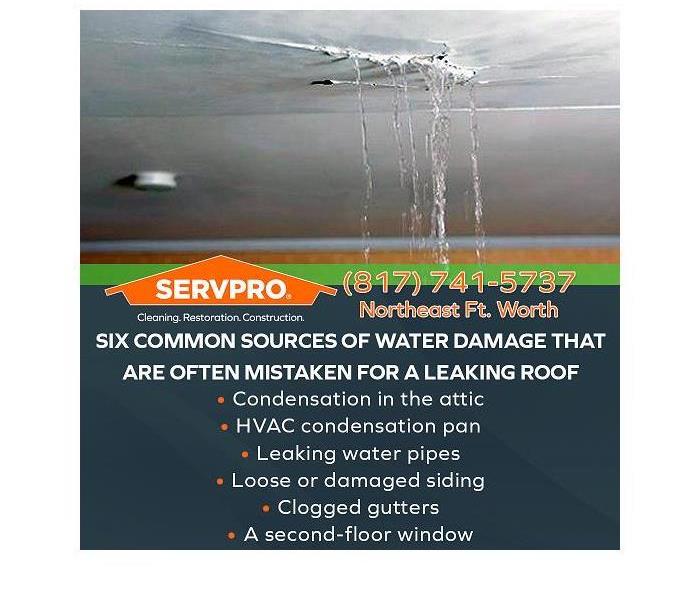Six common causes of water damage often mistaken for a roof leak
3/29/2023 (Permalink)
Blog Summary: When water damage appears on the ceiling or in the attic, the homeowner might assume that the cause is a roof leak. However, the water intrusion could originate from a different source.
SERVPRO® of Northeast Fort Worth provides flood restoration services when storm damage or water damage occurs. Powerful pumps, wet-dry vacuums, heavy-duty dehumidifiers, and rapid spin fans quickly remove water and excess moisture. Advanced moisture-detecting technology ensures the efforts are successful. Advanced cleaning techniques and EPA-approved products are used to clean, disinfect, sanitize, and deodorize the flood-damaged home or business.
A green, brown, or black stain on a sagging, water-logged ceiling may not be a roof leak. Other water sources in the attic or above the ceiling may be the culprit. The diagnosis of the source of the water may be challenging, especially since water can travel a long distance over support timbers, an attic floor, and through the ceiling. Below are six common water damage sources that are often mistaken for a leaking roof.
1. Condensation in the attic
Proper insulation and adequate ventilation are essential for the overall health of the attic. Inadequate insulation and insufficient ventilation allow moisture to accumulate and become trapped in the attic. The moisture will eventually condense, moistening structural timbers, flooring, boxes, clothing, furniture, documents, and other valuables in the attic. An accurate assessment of the situation will require the services of a competent professional. Be sure to operate bathroom and kitchen fans when bathing or cooking to reduce moisture in the home. Make sure all ventilation fans distribute 100% of the moist air to the house’s exterior.
2. HVAC condensation pan
Some homes have part of the HVAC system located in the attic. The evaporator has a condensate pan to catch condensation and exhaust the water to the home's exterior through the condensate pan drain. Over time, the condensate pan may crack and begin to leak. Older condensate pans are made of metal and can develop leaks due to rust, while plastic pans can develop cracks. Sludge and slime can build up and block the drain or clog the pipe evacuating the pan outside the home. Occasionally, a mouse, lizard, or snake could crawl up the drain and clog the system.
An HVAC condensate pan leak can reveal itself in many ways, including the following:
- Brown, green, tan, or black stains appear on the ceiling below the inside unit.
- The ceiling warps, sags, or eventually collapses.
- Affected baseboards swell.
- Paint bubbles and peels.
- Wallpaper separates from the wall.
- A moldy, musty smell is present in the attic and the rest of the home.
On a hot, humid summer day in Blue Mound, TX, an HVAC system can generate about 20 gallons of water. That amount of water in the attic and dispersing through the house can cause serious water damage, especially if no one is home to notice the overflow. To help prevent issues, the homeowner should have a reputable, licensed HVAC professional inspect the entire HVAC system annually to identify any potential or existing issues and make necessary repairs.
3. Leaking water pipes
Plumbing pipes in a two-story home or the attic may develop slow pinhole leaks or collect condensation. The small leaks may mimic a roof leak. Stains on the ceiling, swelling baseboards, and crown molding only indicate a leak but not the source of the leak. A plumber or roofing contractor can inspect the attic and locate the leak source.
4. Loose or damaged siding
Heavy rains accompanied by high winds can penetrate behind the siding. Gaps around windows, punctures and cracks in the siding can allow water to get behind the siding and cause water damage. Mold, mildew, wood rot, and insect infestations can result. The leaks might appear to originate in the roof, but the entry points are related to the siding. Gaps, missing caulk, cracks, and punctures must be identified and repaired. Any mold and rot issues need to be mitigated or repaired.
5. Clogged gutters
Clogged gutters can be the source of water damage around the foundation, behind siding, around windows, and in the attic. When these structures are blocked, the structural integrity of the foundation could be compromised, and the basement could flood. Visually inspect the gutters several times a year. If the tree canopy encroaches on the roof space, check the gutters after every heavy thunderstorm to avoid water damage to the home.
6. A second-floor window
If a house has a second story or a bonus room over the garage, some homeowners will open a window to allow heat to escape the upper part of the home. However, rainwater can blow in and cause wood to rot around the window and beneath the seal, extending to the floor. Hardwood floors, carpeting, and the substrate, can also sustain water damage. Even if the window is kept closed, a pane could be broken or cracked, allowing for a water intrusion during rainy weather. Avoid opening windows to ventilate the second-story or bonus room above the garage, and immediately repair any broken panes or damage around the windows.
In case of water and flood damage, contact the team at SERVPRO of Northeast Fort Worth for immediate results. An IICRC-certified team of property damage restoration professionals can be on the scene in about an hour, 24/7, 365 days a year, including holidays.
For more information about flood damage restoration, contact the SERVPRO of Northeast Fort Worth at (817) 741-5737. The office can also be reached by emailing office@SERVPROnortheastftworth.com.





 24/7 Emergency Service
24/7 Emergency Service
